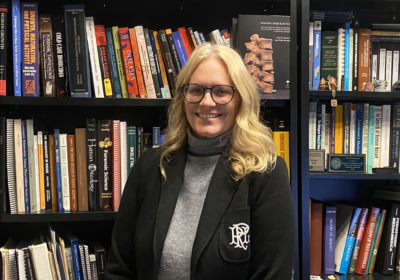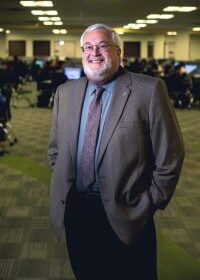OCD far more severe than proverbial neat freak
Betty Ray knew that her son Nathaniel preferred to have his Lego block creations in a precise formation on his bookshelf. When she entered her 7-year-old son’s room to clean, she took a mental photograph of where he had placed them in relation to one another.
She dusted off the ledge and put his blocks back the way he had arranged them – or so she thought. When Nathaniel re-entered his room, he knew immediately that something was wrong.
His mother watched as he meticulously adjusted the Legos to restore them to their original positions, recalling precise angles and distances.
Though they didn’t know at the time, Nathaniel suffers from obsessive-compulsive disorder (OCD). His condition rendered him unable to ignore the disposition of his toys, despite his mother’s efforts to arrange them correctly.
Many college students have probably uttered the phrase “so OCD” when it comes to cleaning their dorm rooms or using proper punctuation in emails. Yet, the term isn’t meant to describe laughable quirks. Rather, it refers to stress-induced thoughts and actions that hinder those diagnosed with it from living full and productive lives.
OCD is a neurobiological anxiety disorder characterized by obsessions and compulsions. OCD causes overwhelming fears and doubts that continually occupy the forefront of the mind. This results in unwanted thoughts, as well as coping rituals that interfere with everyday life.
What separated young Nathaniel from someone who simply “likes things a certain way” was the amount of stress such minute details caused him. In his mind, he didn’t just want his Legos a certain way; he needed them a certain way.
The fourth most common psychiatric disorder, OCD affects one in 100 children and one in 40 adults, meaning more than 1,000 USF students could suffer from this anxiety disorder.
Nathaniel’s physician, Dr. Eric Storch of USF Health, said there is a clear difference between “neat freaks” and those diagnosed with OCD.
“When someone (with OCD) comes through my door, typically their concerns are so prominent that they want to do something about it,” he said.
Experts say 98 percent of people with OCD experience two distinct sets of phenomena: obsessions in the form of intrusive thoughts that dominate the mind and compulsions manifested in performed, repetitive rituals.
What causes OCD is subject to extensive debate and research. Some studies have linked the disorder to a chemical imbalance in the brain, specifically of serotonin. A 2007 study published in Nature magazine showed how mice lacking a vital brain-circuitry protein exhibited “increased anxiety and compulsive grooming behavior.”
Other possible causes include genetic inheritance, as seen in studies that compare OCD twins separated at birth, and traumatic events such as childhood bouts of sickness. Storch said no two cases are the same.
“One example I give is a boy who counted shapes with a 90-degree angle,” he said. “In his case, he was in a classroom that had a brick wall. Every time he’d lose count, he’d have to start anew.”
Storch said engaging in OCD-induced rituals can often lead to a misdiagnosis of other conditions, such as attention deficit disorder. The boy’s teacher mistook his ritual as another case of an inattentive student, even though he had no choice but to count every brick in the classroom.
Storch said cases such as this exemplify the obvious difference between someone with OCD and someone simply labeled “obsessed.”
“With kids, you’ll see a lot of video game playing, and the parent will say, ‘My kid’s obsessed with video games,'” he said. “That’s not OCD to the extent that there’s not something that’s distressing the child in the form of an intrusive thought, and certainly no compulsion related to it.”
Three years after his mother noticed him adjusting his Legos, Nathaniel sat with his parents watching television. Even though he hadn’t done anything wrong, Nathaniel began apologizing to his mother.
“In a 30-minute time span, he apologized over 60 times. I finally quit counting,” Betty said. “And I said, ‘OK, this is not normal.'”
Diagnosing OCD isn’t done with lab equipment or brain scans, but rather by conducting a clinical interview. Storch said the two indicators he looks for are obsessions that slow down patients’ days and the degree of stress caused by their inability to perform a ritual.
Nathaniel and his mother compiled a list of obsessions and compulsions severe enough to cause him anxiety. Nathaniel then began cognitive behavioral therapy, which targeted his specific compulsions. After he and his mother ranked them in terms of severity, Storch began exposing him to his obsessions, starting with things that caused him the least anxiety.
Forced to see his Legos out of place time after time, Nathaniel slowly began to build up a mental immunity to the circumstance that had before made him overly anxious. These weekly therapy sessions slowly allowed him to manage his OCD.
Storch researches treatment options for OCD through USF. Though some drugs are available for OCD, Storch said the therapy has proved most effective.
“Whenever I hear someone say, ‘OCD is a biological disorder or a brain disorder,’ I take pretty strong offense to that because it neglects the most robust data that we have, which is that exposure-based psychotherapy is the most profound treatment,” he said.
Storch’s research, recently featured in the St. Petersburg Times, has shown that a drug, currently FDA approved for tuberculosis, has enhanced the cognitive therapy treatment in a number of children. The next step toward approving the drug for OCD involves more than 100 child patients, some given the drug and others given a placebo.
Today, Nathaniel is 15 years old and plays wide receiver for the junior varsity football team at Timber Creek High School. Though it takes him longer to finish his school work than it does for his peers, Nathaniel maintains a 4.0 grade point average. Therapy sessions over the past five years have given him the tools needed to stop OCD from running his life. He occasionally visits Storch for booster sessions.
“Because of the (cognitive behavioral) therapy, I have become a stronger person,” Nathaniel said. “I’ve learned to manage my OCD, rather than my OCD managing me.”






